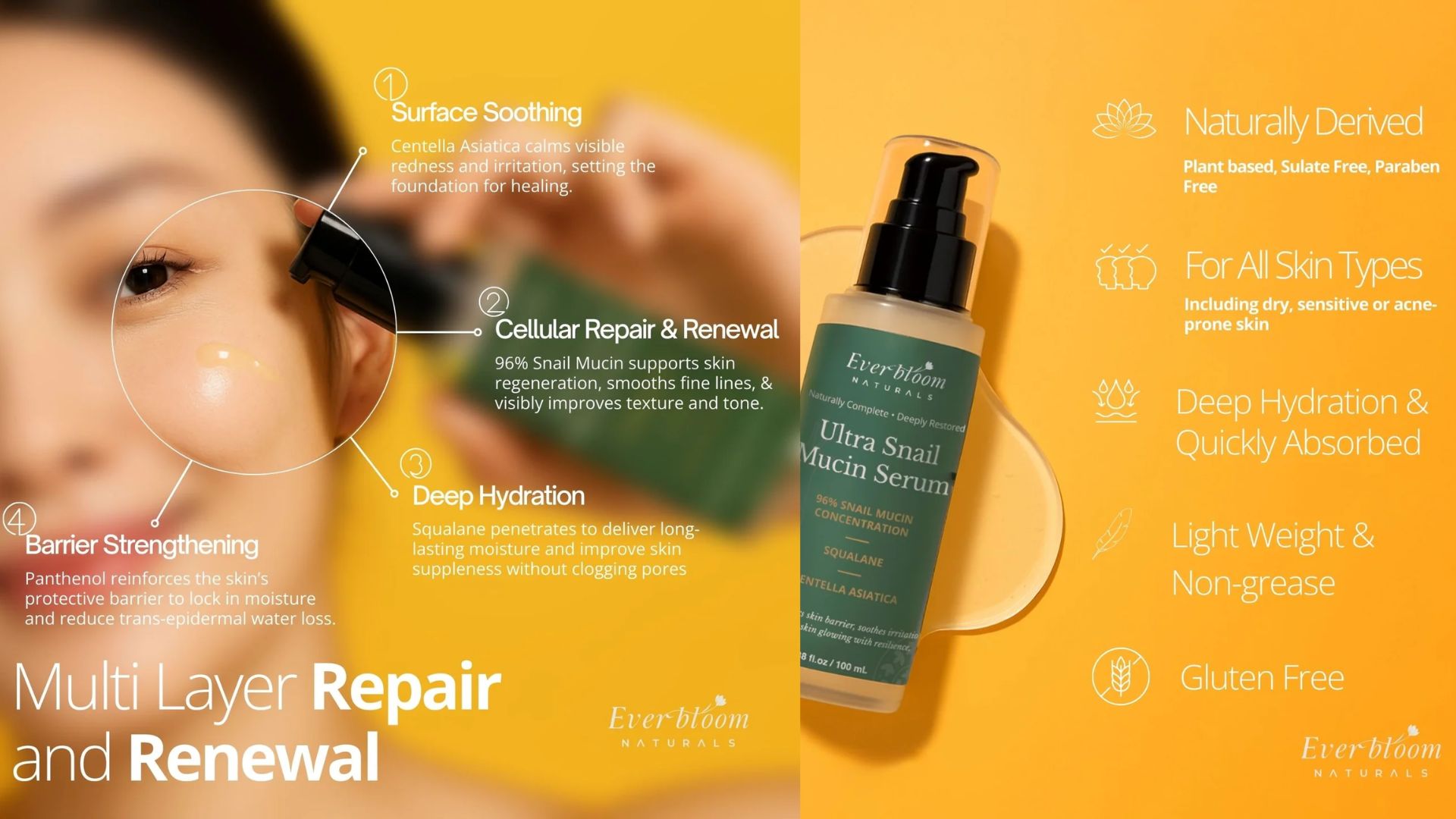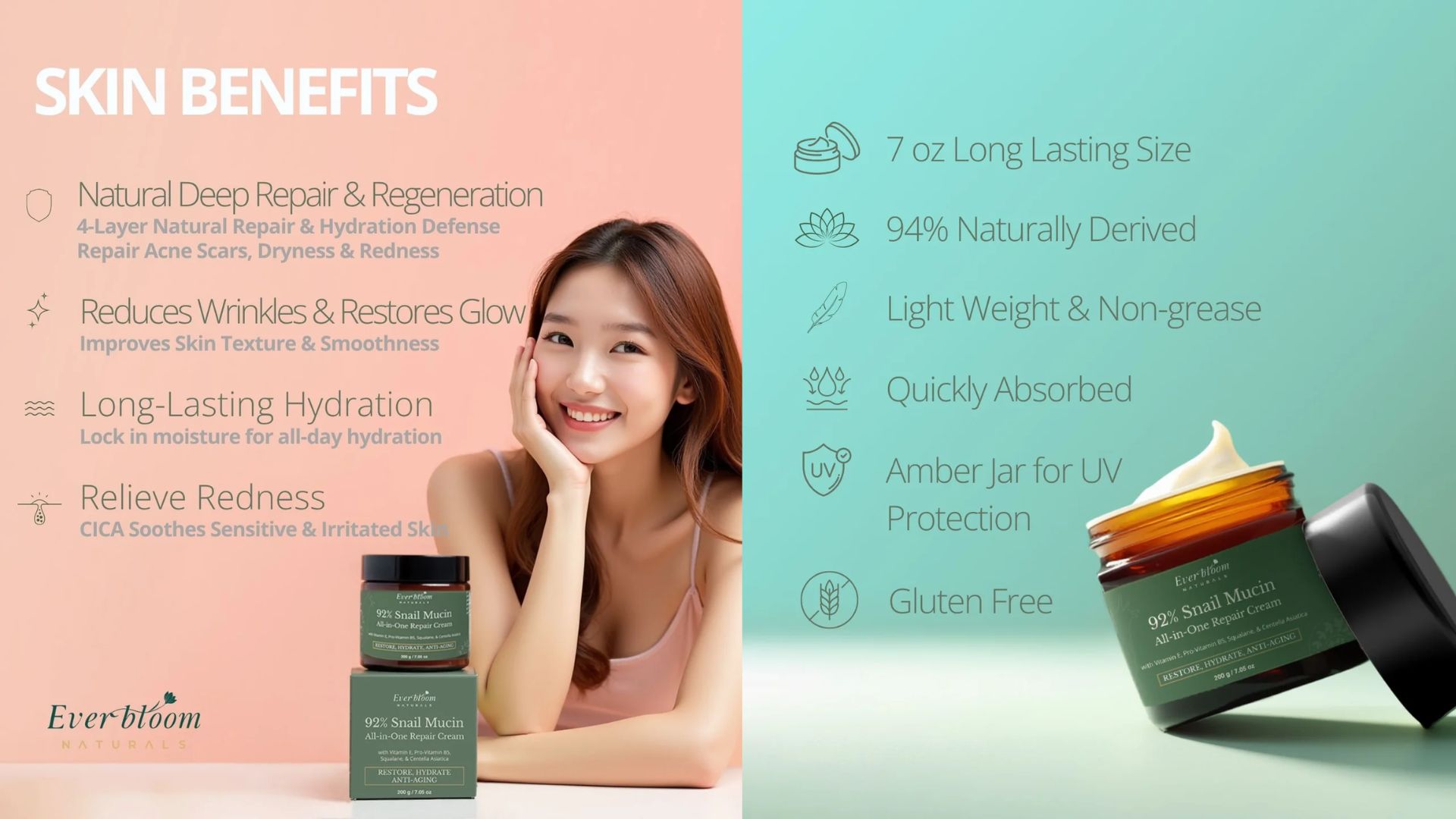
Key Takeaways
(6 min read)
Q1:What are the main skin benefits of snail mucin?
A: Snail mucin is a multitasking ingredient known for deeply hydrating the skin, soothing irritation, and helping to repair the skin barrier and fade acne scars over time. The visible effects of snail mucin on skin are a key reason for its popularity.
Q2: What makes snail mucin so effective?
A: It's a natural cocktail of skin-benefiting compounds, including hyaluronic acid for hydration, glycolic acid for gentle exfoliation, allantoin for soothing, and peptides to support collagen production.
Q3: Is snail mucin safe for everyone?
A: While generally safe, those with dust mite or mollusk/shellfish allergies should exercise caution and patch-test first. Not all snail mucin results are the same for everyone.
Q4: Is collecting snail mucin cruel?
A: Many reputable companies use cruelty-free methods where snails crawl over mesh in a comfortable environment, leaving mucin behind naturally. Everbloom Naturals' snail mucin cream and serum are cruelty-free.

Introduction
The beauty world is buzzing about one unconventional ingredient: snail mucin. Social media is filled with incredible snail mucin before and after videos, showcasing transformations from achieving "glass skin" to diminishing acne scars and wrinkles [1], [2]. But what's the real story behind the hype? This guide will explore the science, benefits, and realistic snail mucin results you can expect.
We'll look at the history of snail secretion filtrate, examine the science behind its benefits, and scrutinize the before and after snail mucin evidence, from user testimonials to clinical research. Our goal is to provide a balanced perspective on this intriguing ingredient.
What's the Goo? Unpacking Snail Mucin
The use of snail mucin isn't new; it dates back to ancient Greece, where Hippocrates used it for its anti-inflammatory properties [5]. Its modern resurgence began with Chilean escargot farmers who noticed their hands were remarkably soft and cuts healed quickly [1]. This led to its explosion in popularity, largely thanks to Korean Beauty (K-Beauty), which made it a global phenomenon [7].
The Science of Slime: Key Components
The magic of snail mucin lies in its complex blend of bioactive compounds [3]. Here’s what makes it a powerhouse:
- Hyaluronic Acid: Deeply hydrates and plumps the skin [3].
- Glycolic Acid: Gently exfoliates, improving texture and reducing hyperpigmentation [3].
- Allantoin: Soothes irritation, reduces redness, and promotes healing [3].
- Peptides: Stimulate collagen, improving firmness and reducing fine lines [8].
- Antioxidants & Antimicrobials: Protect from environmental damage and help manage acne [3].
This natural synergy makes it a multitasking ingredient that addresses multiple concerns at once, explaining its broad appeal [9].
The "After" Effect: What Snail Mucin Really Does
The reported snail mucin before after transformations cover a wide range of skin improvements. Here’s a breakdown of the benefits.
- Hydration (The "Glass Skin" Effect): Thanks to hyaluronic acid, it provides intense moisture, leading to a plump, dewy look [4].
- Anti-Aging: Peptides and glycoproteins stimulate collagen, which can soften fine lines. Many users search for snail mucin before and after wrinkles photos, and while results vary, some report visible improvements with consistent use [11].
- Healing Acne, Scars, and Irritation: Allantoin and glycolic acid promote tissue repair. The internet is full of impressive snail mucin acne scars before and after stories, with users noting reduced inflammation and faded marks [14], [2].
- Improved Texture and Tone: Gentle exfoliation and hydration lead to smoother, softer, and brighter skin [15].

Expert Opinions & Realistic Expectations
Dermatologists acknowledge snail mucin's benefits, particularly for hydration and soothing, thanks to its composition [8]. Clinical research supports its role in wound healing and hydration, and some studies show promise for anti-aging and acne treatment [7], [20]. However, experts view it as a supportive "hyaluronic acid plus" product rather than a standalone miracle cure [19]
How to Use Snail Mucin
Snail mucin comes in essences, serums, and creams. A popular choice is an essence, and many snail mucin essence before and after stories highlight its effectiveness.
- When to Apply: Apply after cleansing and toning, but before heavier creams. Using it on damp skin enhances absorption [9].
- How to Layer: It pairs well with hyaluronic acid, niacinamide, and even potent actives like retinoids and Vitamin C, as its soothing properties can help reduce irritation [24].
- Patch Test: Always patch-test first, especially if you have sensitive skin or allergies to shellfish or dust mites [24].
Whether you're trying a snail cream before and after an active treatment or as a daily hydrator, proper application is key.
Product Spotlight: Everybloom Naturals Snail Mucin Skincare Duo
Discover the ultimate K-beauty duo for radiant, hydrated skin—featuring Everybloom Naturals' 96% Snail Mucin Repair Serum and 92% Snail Mucin Face Moisturizer Cream.
✨ The 96% Snail Mucin Serum is a lightweight, fast-absorbing formula powered by high-purity snail mucin, Centella Asiatica (CICA), and squalane. It visibly fades acne scars, smooths fine lines, and strengthens your skin barrier—all without irritation. Ideal for layering under makeup or other serums, this hydrating serum brings your glow back to life.

💧 Follow with the 92% Snail Mucin Moisturizer, a generous 7oz cream packed with moisture-sealing squalane, soothing CICA, and protective Vitamin E. It’s non-comedogenic, fragrance-free, and perfect for sensitive, dry, or combination skin—your new go-to for long-lasting hydration and softness.

Together, this powerful pairing offers deep repair, brightening, and anti-aging care for every skin type. Clean, cruelty-free, and inspired by Korean skincare science—because your skin deserves nothing less. 💚
Conclusion: Is Snail Mucin Your Holy Grail?
Snail mucin has earned its place in skincare for its proven ability to hydrate, soothe, and support skin repair. Its multifaceted nature addresses many concerns, and countless positive snail mucin before and after stories back this up. However, results are personal. Approach it with realistic expectations, and always patch-test. While not a miracle cure, it can be a wonderfully effective ally for achieving healthier, more resilient skin.
References
- The Rise of Snail Mucin: A Skincare Sensation and Its Alternatives ..., https://sytheonltd.com/the-rise-of-snail-mucin-a-skincare-sensation-and-its-alternatives/
- All Eyes on: Snail Mucin – Skin Quench, https://skinquench.blog/2019/03/25/all-eyes-on-snail-mucin/
- An Introduction to Snail Mucin for Skincare - Lumadea USA, https://lumadeausa.com/blogs/news/what-is-snail-mucin
- What Are the Benefits of Snail Mucin? - Healthline, https://www.healthline.com/health/snail-mucin-benefits
- nationaleczema.org, https://nationaleczema.org/blog/snail-mucin/#:~:text=Snail%20mucin%20might%20seem%20like,aging%20agent%2C%20according%20to%20Dr.
- Helix and Drugs: Snails for Western Health Care From Antiquity to the Present - PMC, https://pmc.ncbi.nlm.nih.gov/articles/PMC1062150/
- Current Clinical and Aesthetic Applications of Snail Mucin - Dermatology Times, https://www.dermatologytimes.com/view/current-clinical-and-aesthetic-applications-of-snail-mucin
- Get the Facts on Snail Mucin and Eczema, https://nationaleczema.org/blog/snail-mucin/
- What is Snail Mucin and What are the Benefits | Ulta Beauty, https://www.ulta.com/discover/beauty-education/what-is-snail-mucin
- Snail Mucin: Benefits, Uses, and Effectiveness - WebMD, https://www.webmd.com/beauty/what-is-snail-mucin
- Snail Mucin Wrinkle Before After | TikTok, https://www.tiktok.com/discover/snail-mucin-wrinkle-before-after
- COSRX Snail Mucin Skin Care: 30 Day Test - THIS IS REAL LIFE ..., https://www.youtube.com/watch?v=G48pMxazoCo
- www.bjbms.org, https://www.bjbms.org/ojs/index.php/bjbms/article/download/11067/3423
- I Tried the CosRX Snail Mucin—Here's My Honest ... - Prevention, https://www.prevention.com/beauty/skin-care/a63384785/cosrx-advanced-snail-96-mucin-power-essence-review/
- Skincare Game-Changer: COSRX's Best-Sellers Win Over Global Consumers, https://brandingforum.org/news/beauty/cosrx-products/
- Snail mucin experience : r/AsianBeauty - Reddit, https://www.reddit.com/r/AsianBeauty/comments/1g9zhhy/snail_mucin_experience/
- I've been using cosrx snail mucin since many months as I fell for the hype and it felt good on my skin although it didn't do much. I apply it after I apply the minimalist niacinimide serum. Can I get an alternative for the cosrx snail mucin serum. I have acne prone oily skin. : - Reddit, https://www.reddit.com/r/IndianSkincareAddicts/comments/10iho1o/ive_been_using_cosrx_snail_mucin_since_many/
- From Nature to Nurture: The Science and Applications of Snail Slime in Health and Beauty, https://pmc.ncbi.nlm.nih.gov/articles/PMC11840295/
- [Research] Derm's review of the evidence for snail mucin : r/SkincareAddiction - Reddit, https://www.reddit.com/r/SkincareAddiction/comments/1atwpv5/research_derms_review_of_the_evidence_for_snail/
- Effect of Helix aspersa Mucus on the Regeneration of Skin with Photoaging Features in Different Methods of Application - MDPI, https://www.mdpi.com/2076-3417/14/16/7394
- What Do Dermatologists Think of Snail Mucin? The Truth Revealed - SeoulCeuticals, https://seoulceuticals.com/blogs/news/what-do-dermatologists-think-of-snail-mucin-the-truth-revealed
- Pure Snail Mucin - Etsy, https://www.etsy.com/market/pure_snail_mucin?ref=lp_queries_internal_bottom-21
- Is Snail Mucin Good for Every Skin Type? An Honest Review - SeoulCeuticals, https://seoulceuticals.com/blogs/news/snail-mucin-by-skin-type
- Snail Mucin for Skin: What It Is, Benefits, Side Effects - Verywell Health, https://www.verywellhealth.com/snail-mucin-for-skin-8408384
- Snail Mucin: Benefits, Uses, and Risks - Health, https://www.health.com/snail-mucin-benefits-uses-and-risks-7644018
- What Is Snail Mucin and How Is It Collected for Skincare Products? - PETA, https://www.peta.org/living/personal-care-fashion/what-is-snail-mucin-in-skincare/
- Is Snail Mucin REALLY Cruelty-Free? Here's the Truth ..., https://seoulceuticals.com/blogs/news/is-snail-mucin-really-cruelty-free-here-s-the-truth
- Best Cruelty-Free Korean Skincare Products You Need to Try - EYURS, https://www.eyurs.com/blogs/beauty/10-best-cruelty-free-korean-skincare-products-you-need-to-try
- RoyeR Cosmetique 100% Pure Snail Mucin Eye ... - Amazon.com, https://www.amazon.com/RoyeR-Cosmetique-Certified-Organic-Cruelty/dp/B0CBCVZTSD
- Recommitment List - Leaping Bunny, https://www.leapingbunny.org/recommitment-list
- March 2025 - Which brands remain Leaping Bunny certified?, https://www.leapingbunny.org/node/330898
- The Official Cruelty Free K-Beauty Guide - Ethical Bunny, https://www.ethicalbunny.com/kbeauty/
- Snail mucin cosmetics - RoyeR Cosmétique, https://www.royercosmetique.fr/en/
- RoyeR Cosmetique 100% Pure Organic Snail Mucin Serum, Made in France - Luxury Beauty Serum & Skin Repair Serum, 1 Oz. - Amazon.com, https://www.amazon.com/RoyeR-Cosmetique-Fresh-Organic-Snail/dp/B086C8NGBS
- ECOCERT Certified Natural Cosmetics - Ecco Verde Online Shop, https://www.ecco-verde.com/categories/ecocert


